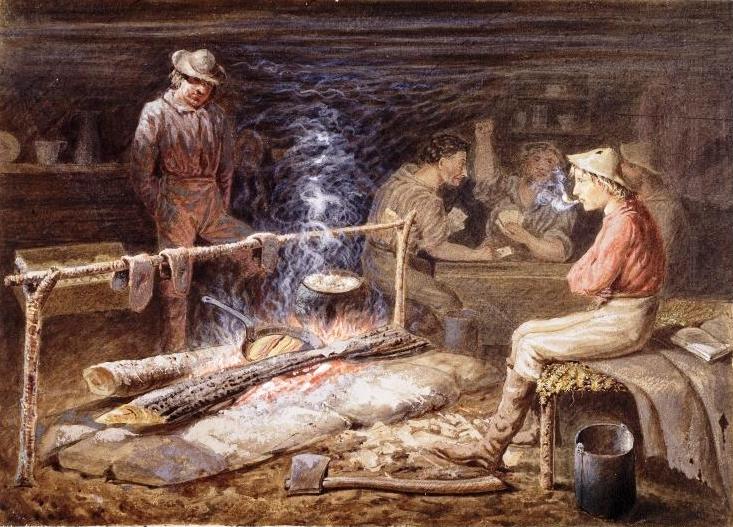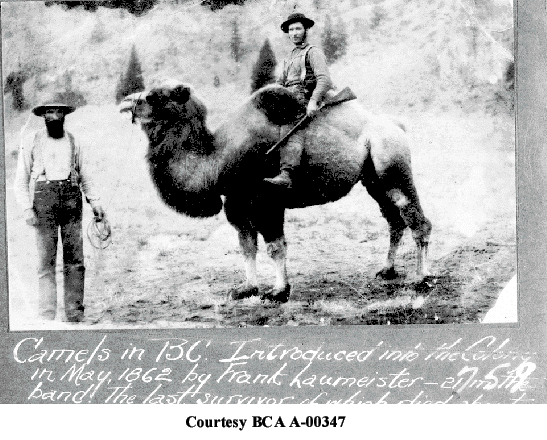

The Monashee Almanac is an online journal that shares history, mysteries and stories about early British Columbia and in particular the Monashee, Okanagan and Shuswap.
Celebrating History, Mysteries & Stories
Beginnings at Cherry Creek
An Okanagan Historical Society account from 1929
Painting: Cabin on the Fraser, B.C., "The Bacon is Cooked", by William Hind, about 1862, Watercolour, gouache and graphite on paper
Placer miners were a nomadic group for whom towns served as temporary lodging rather than a place to settle down. Artist William Hind depicted the life of miners through a series of works. This one portrays a group of men in a cabin on the Fraser River called The Bacon is Cooked and was believed to be painted in 1862.
For almost 100 years we have developed a very positive view about the early beginnings of the Okanagan, but perhaps there is much more to learn. Mrs. Angus Woods wrote of the Cherry Creek mines in the 1929 edition of the Okanagan Hisorical Society Report. She writes an optimistic account on the mining activity as recorded by the newspaper the “British Columbian” on November 21, 1863.
“Mr. Penny of Lytton came down by the “Reliance” last night he has just returned from a tour of inspection throughout the Shuswap country.
He says the principal mining is on Cherry Creek, a stream about the size of Antler Creek in the Cariboo. Cherry Creek empties into the Shuswap River. Mr. Penny showed us a prospect of $2.75 which he himself obtained from ten buckets about nine miles above its mouth.
Charles Kendall has the contract from the government for the construction of two bridges over the Shuswap River, one at the lower ford and one at the upper. He is to receive the tolls for two years when the government takes them over at half the cost.
Mr. Penny says that at least 200 men will winter there. When he left there was neither frost nor snow, and he describes the country as being the most beautiful in the colony, so level and open is much of it, that several carriages may be driven abreast for miles.
From Savannah’s (Savona’s) Ferry, 18 Miles from Bonaparte, to within a few miles of Cherry Creek, a distance of 150 miles, is navigable for steamers, being almost still water. Preparations are now in progress for placing a steamer on that route in the spring.
Packers are wintering their animals within fifty miles of the mines, so mild is the climate”.
Woods describes another article in the “British Columbian” published July 9, 1864 which states: “A gentleman engaged in the packing business came over from the Kootenay country via Shuswap. In passing trough the Shuswap country he called at Cherry Creek and examined the mines. There were three companies at work, one claim was paying $20 per day to the hand, and none less than $10. The water was still high and it was expected as it fell, richer pay would be obtained”.
It is difficult to get authentic and accurate information as to what happened on Cherry Creek during the following four or five years following the discovery of gold. Sometimes the mines appear to have yielded lots of gold and at other times they were almost deserted by the miners.
Woods identifies in 1929, that information is sparse and that any history of the discovery is obtained from old letters and the files of old newspapers. There was no annual report by the gold commissioners, duly printed by the government in those days.
Woods states “That the old newspapers seem to be strangely silent as to what took place during the last four or five months in 1864, but we are reasonably sure that the two bridges mentioned were not built. The first steam boat on Shuswap Lake was the Martin, a boat of a 100 tons burden and 90 horsepower, built by the Hudson’s Bay Company, not for trade between Savona’s Ferry and Shuswap Falls, but for trade between Savona’s Ferry and the little town of Seymour on the shore of Seymour Arm at the end of the trail into Big Bend mines.
Since 1929 the trappings of history have been expanded as scores of historians seek to discover the events and personalities belonging to this earlier age of British Columbia. What we know today is that in 1862 the colony was in a chaotic state, with gold being discovered in every part of the region and prospectors flooding in from everywhere. What was driving these migrations of people, was it just gold, or was it the state of the world?

In 1862, 23 pack camels arrived in Victoria from San Francisco. Camels had been successful in the United States army for several years and it was believed that they would make excellent pack animals in the Cariboo gold rush. Several Victoria businessmen, including Frank Laumeister and Charles Gowan, were involved in the venture.
Between their arrival in Victoria and the voyage to the mainland, the camels found a home behind Esquimalt Halfway House Saloon and Brewery. This attraction brought crowds of Victorians and undoubtedly served as an excellent advertising tool for the brewery.
The use of Camels in the gold rush was largely viewed as a failure. The camels caused problems on the trail because they frightened other pack animals. Also, the camel's feet were not designed to traverse the rocky terrain, being used to desert sand. Nevertheless the animals inspired a namesake that serves as the Gateway to the Monashee – the Camels Hump.
The Camels Hump
Where the unusual landmark got its name